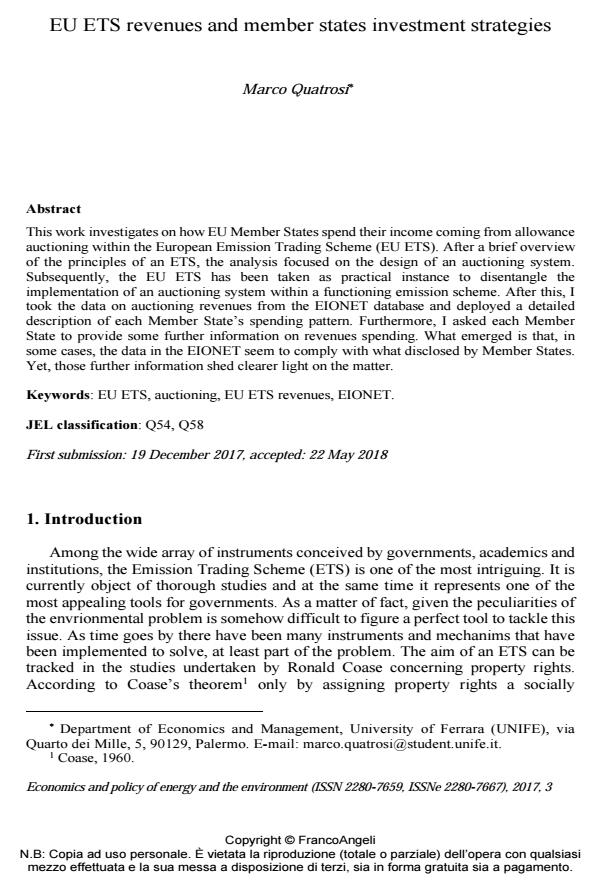EU ETS revenues and member states investment strategies
Titolo Rivista ECONOMICS AND POLICY OF ENERGY AND THE ENVIRONMENT
Autori/Curatori Marco Quatrosi
Anno di pubblicazione 2018 Fascicolo 2017/3
Lingua Inglese Numero pagine 17 P. 41-57 Dimensione file 265 KB
DOI 10.3280/EFE2017-003003
Il DOI è il codice a barre della proprietà intellettuale: per saperne di più
clicca qui
Qui sotto puoi vedere in anteprima la prima pagina di questo articolo.
Se questo articolo ti interessa, lo puoi acquistare (e scaricare in formato pdf) seguendo le facili indicazioni per acquistare il download credit. Acquista Download Credits per scaricare questo Articolo in formato PDF

FrancoAngeli è membro della Publishers International Linking Association, Inc (PILA)associazione indipendente e non profit per facilitare (attraverso i servizi tecnologici implementati da CrossRef.org) l’accesso degli studiosi ai contenuti digitali nelle pubblicazioni professionali e scientifiche
This work investigates on how EU Member States spend their income coming from allowance auctioning within the European Emission Trading Scheme (EU ETS). After a brief overview of the principles of an ETS, the analysis focused on the design of an auctioning system. Subsequently, the EU ETS has been taken as practical instance to disentangle the implementation of an auctioning system within a functioning emission scheme. After this, I took the data on auctioning revenues from the EIONET database and deployed a detailed description of each Member State’s spending pattern. Furthermore, I asked each Member State to provide some further information on revenues spending. What emerged is that, in some cases, the data in the EIONET seem to comply with what disclosed by Member States. Yet, those further information shed clearer light on the matter..
Parole chiave:EU ETS, auctioning, EU ETS revenues, EIONET
Jel codes:Q54, Q58
- Antonioli D., Borghesi S., D’Amato A., Gilli M., Mazzanti M., Nicolli F. (2014). Analysing the interactions of energy and climate policies in a broad policy ‘optimality’ framework: the Italian case study. Journal of Integrative Environmental Sciences, 11(3-4): 205-224.
- Asian Development Bank (2016). Emission Trading Schemes and their linking: challenges and opportunities in Asia and the Pacific.
- BHM17173883 communication with the Central Unit for Civilian Correspondence, Communications Department, Ministry of Economic Affairs and Climate Policy, the Netherlands.
- Borghesi S., Montini M., Barreca A. (2016). The European emission trading system and its followers comparative analysis and linking perspectives. Springer.
- Coase R.H. (1960). The problem of social cost. The Law & Economics Journal. Commission Guidelines on certain State aid measures in the context of the greenhouse gas emission allowance trading scheme post-2012, OJ C 158, 05.06.2012, p. 4. As modified by Communication 2012/C 387/06, OJ C 387, 15.12.2012, p. 5.
- Commission Implementing Regulation (EU) No 749/2014 of 30 June 2014 on structure, format, submission processes and review of information reported by Member States pursuant to Regulation (EU) No 525/2013 of the European Parliament and of the Council.
- Commission Regulation (EU) No 1031/2010 of 12 November 2010 on the timing, administration and other aspects of auctioning of greenhouse gas emission allowances pursuant to Directive 2003/87/EC of the European Parliament and of the Council establishing a scheme for greenhouse gas emission allowances trading within the Community.
- Del Rio P. (2009). Interactions between climate and energy policies: The case of Spain. Climate Policy, 9(2): 119-138.
- European Directive 2003/87 of the European Parliament and of the Council establishing a scheme for greenhouse gas emission allowance trading within the Community and amending Council Directive 96/61/EC, 2003.
- Grubb M. (2012). Strengthening the EU ETS Creating a stable platform for EU energy sector investment. Climate Strategies. -- http://www.envir.ee/sites/default/files/enampakkumistulu_kasutamise_aruanne_2016._a_kohta.pdf.
- -- https://www.gov.uk/guidance/uk-carbon-capture-and-storage-government-funding-and-support.
- Institute for Climate Economics (2015). EXPLORING THE EU ETS BEYOND 2020. A first assessment of the EU Commission’s proposal for Phase IV of the EU ETS (2021-2030).
- International Bank for Reconstruction and Development / The World Bank. (2016). Emission Trading in Practice: A Handbook on design and implementation.
- Lopomo G., Marx L.M. (2009). Carbon Allowance Auction Design: An Evaluation of the Current Debate
- The European Union Emission Trading System and its role for green budgeting development — the case of EU member states Kamilla Marchewka-Bartkowiak, in Current Opinion in Environmental Sustainability 101390/2023 pp.101390
DOI: 10.1016/j.cosust.2023.101390 - Handbook of Research on Climate Change and the Sustainable Financial Sector Kamilla Marchewka-Bartkowiak, Klaudia Jarno, pp.34 (ISBN:9781799879671)
Marco Quatrosi, EU ETS revenues and member states investment strategies in "ECONOMICS AND POLICY OF ENERGY AND THE ENVIRONMENT" 3/2017, pp 41-57, DOI: 10.3280/EFE2017-003003